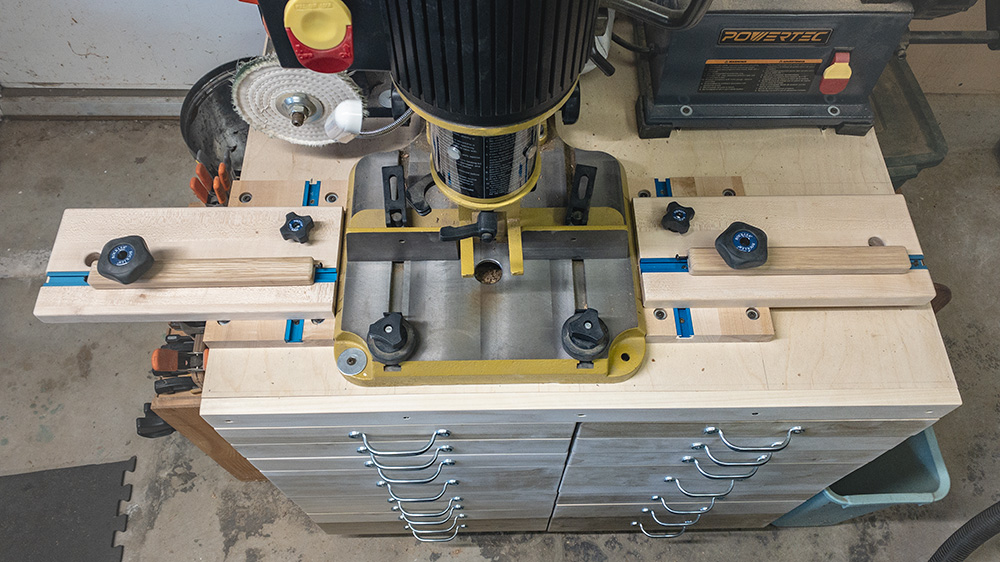
The importance of stops on shop equipment cannot be understated. While we all strive toward accuracy, attempting to achieve complete and total accuracy is very hard, and frankly, a bit of a waste of time. Stops allow us to be consistent, and at the end of the day, consistency is more important than accuracy. For example, if we try to make a chair using four legs of varying lengths, all you’ll get is a headache. If we make them all consistent, however, we can deal with that much easier.
We typically find official stops (or jerry-rigged stops) on our miter fences, table saw sleds, radial arm saws, drill presses, router tables, chop saws, band saws, etc. What we seldom see are efficient and easy-to-use stops on our benchtop mortisers. In this article, I’ll show you how I created my own Ultimate Mortise Stop System.
Download The Ultimate Mortiser Stop System Plans
Parts of the Ultimate Mortise Stop System
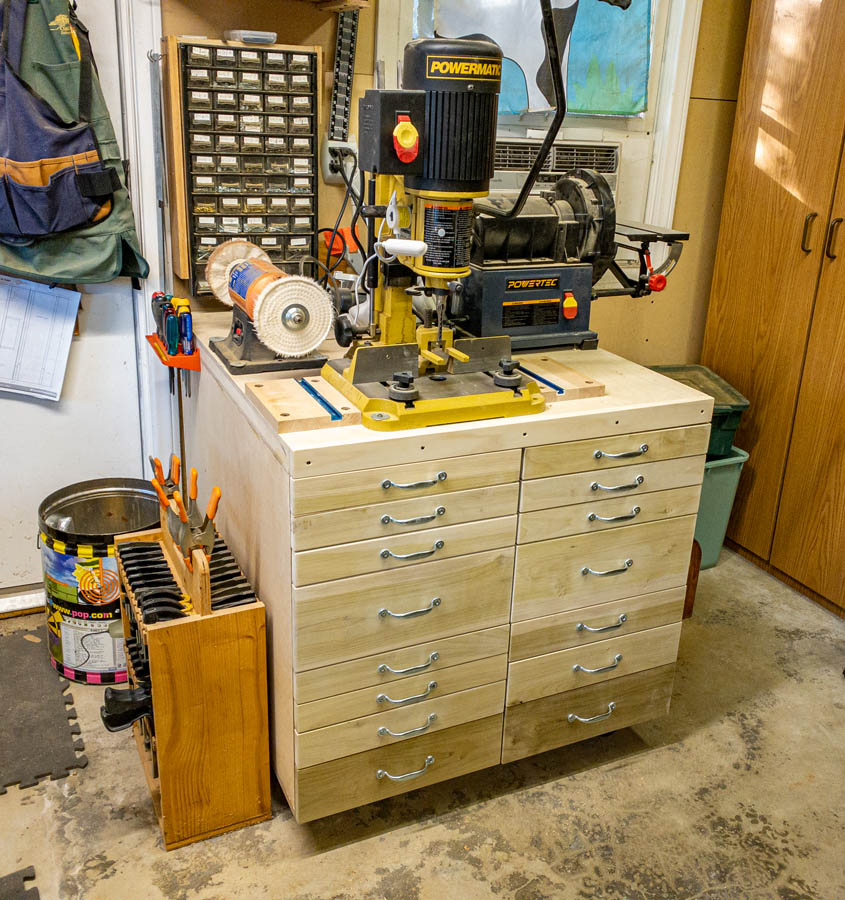
Here is my completed mortising bench/cabinet showing just the base of the stop system without the wings. (Making this cabinet gave me the opportunity to add several much-needed drawers to my shop.)
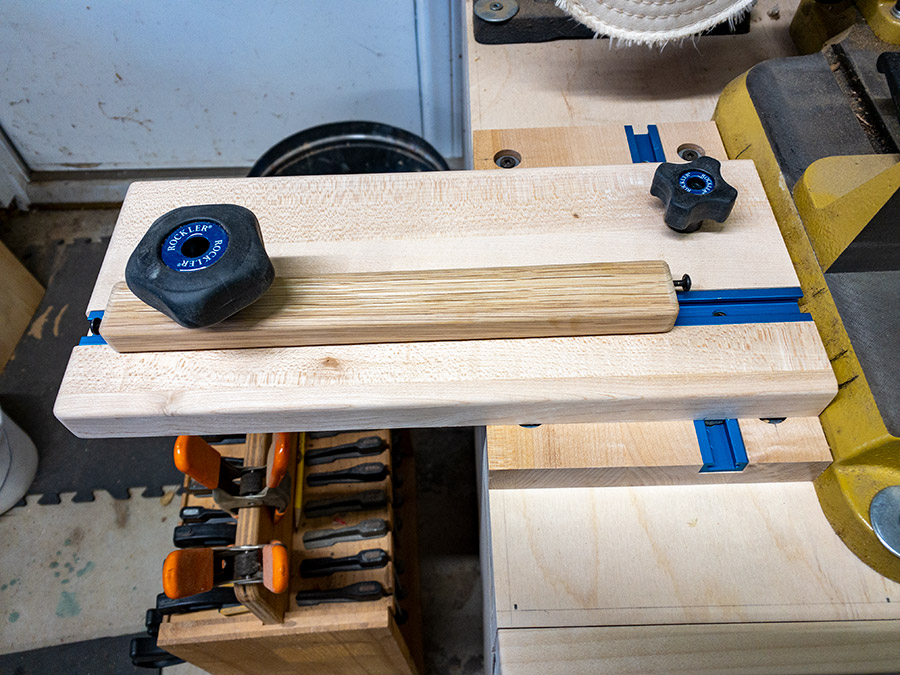
This is a close-up of the left side of the mortise stop system with all of the parts in place to give you an idea of what the finished product will look like. The mortise stop system is composed of three parts:
1: The Base
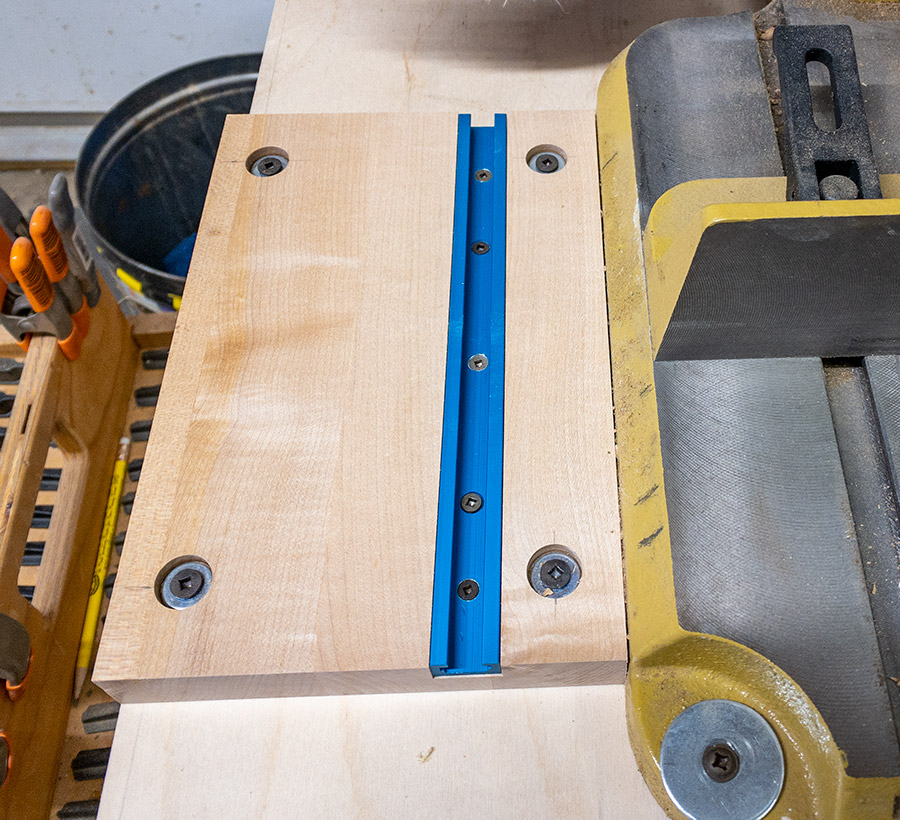 This is attached to the table-top surface and is half the height of the mortise’s working surface. The base has a T-track running up and down its length. This allows you to move the stop back and forth following the position of the mortiser’s fence.
This is attached to the table-top surface and is half the height of the mortise’s working surface. The base has a T-track running up and down its length. This allows you to move the stop back and forth following the position of the mortiser’s fence.
2: The Wing
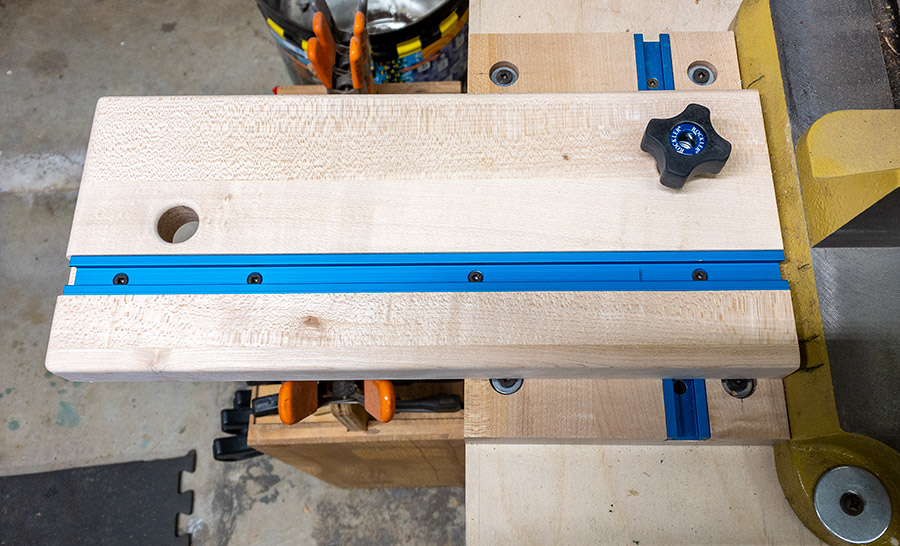 This is attached to the base via a T-track bolt. Wings can be any length and each have a T-track running down its full length. The wings also serve an important function to extend the width of your mortiser’s base and provide support to long pieces of wood that are placed across them while cutting.
This is attached to the base via a T-track bolt. Wings can be any length and each have a T-track running down its full length. The wings also serve an important function to extend the width of your mortiser’s base and provide support to long pieces of wood that are placed across them while cutting.
3: The Stop
 This is a piece of wood long enough to reach across the base to meet the mortising bit. The stop has a hole for a T-track bolt near one end, and both ends have a round-head screw to provide simple and fast micro-alterations of the stop’s position. All edges have been rounded over to make them easier to handle.
This is a piece of wood long enough to reach across the base to meet the mortising bit. The stop has a hole for a T-track bolt near one end, and both ends have a round-head screw to provide simple and fast micro-alterations of the stop’s position. All edges have been rounded over to make them easier to handle.
How to Use the Ultimate Mortise Stop System
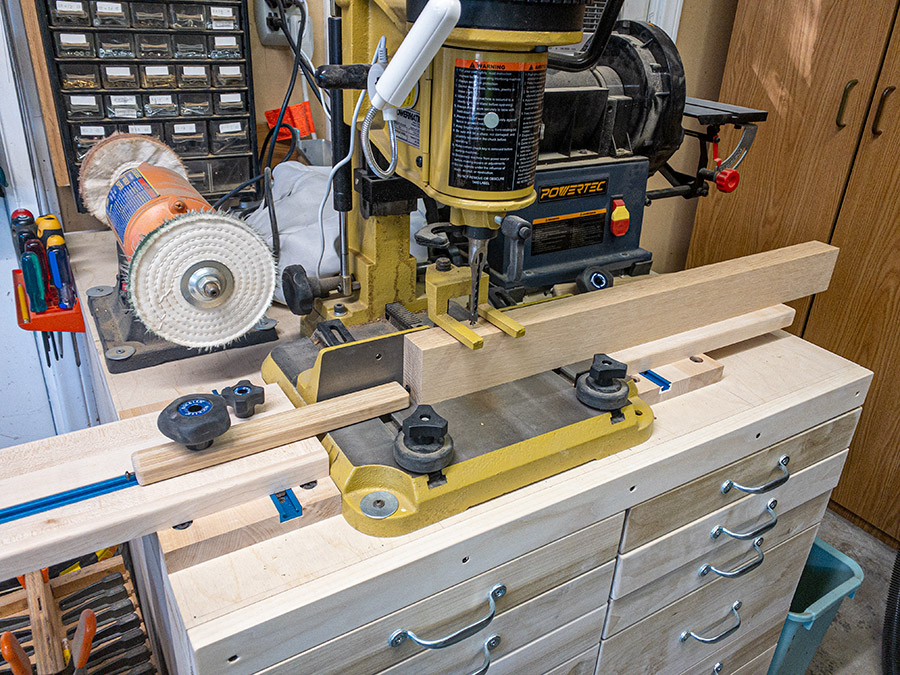
The stop is designed so that it can extend across the mortiser’s base and get as close to the mortise bit as needed. Note in the image above how the wings help support long pieces of wood.
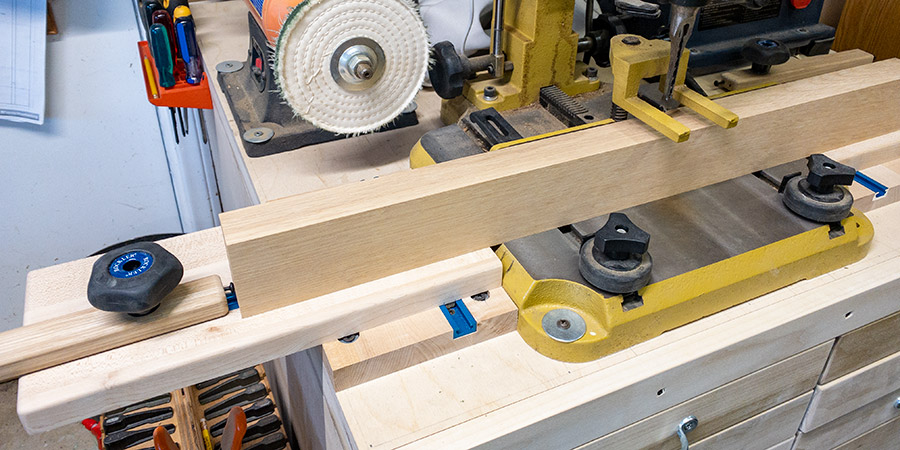
You can also flip the stop around allowing you to easily put a mortise in the middle of a leg if needed.
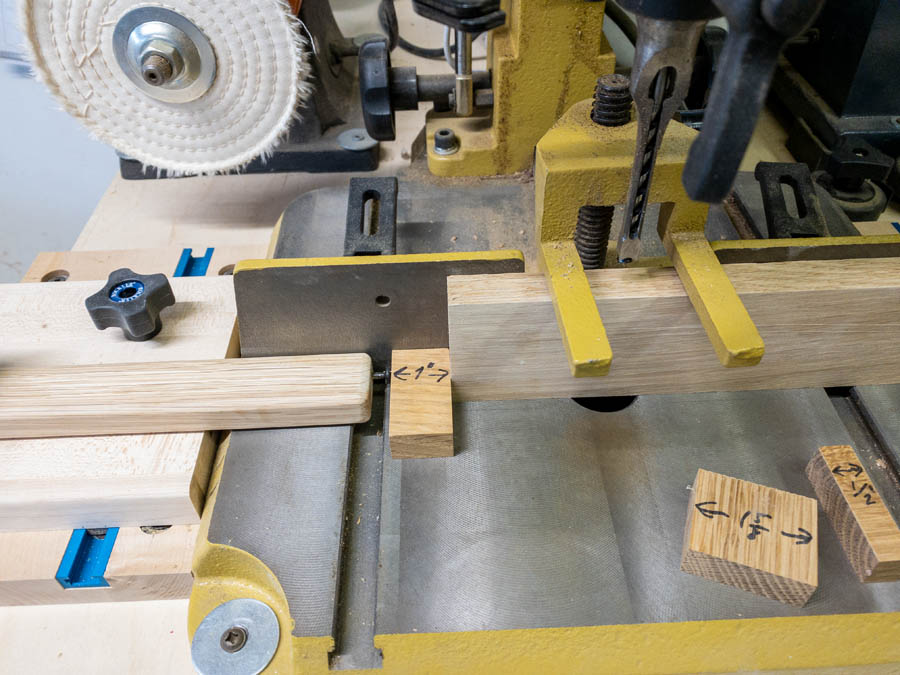
When making a rectangular mortise, you can use a spacer to drill the first hole, remove the spacer, drill the hole at the other end of the mortise, then drill out everything in between those two holes. Every time I make a new spacer, I keep it for future use.
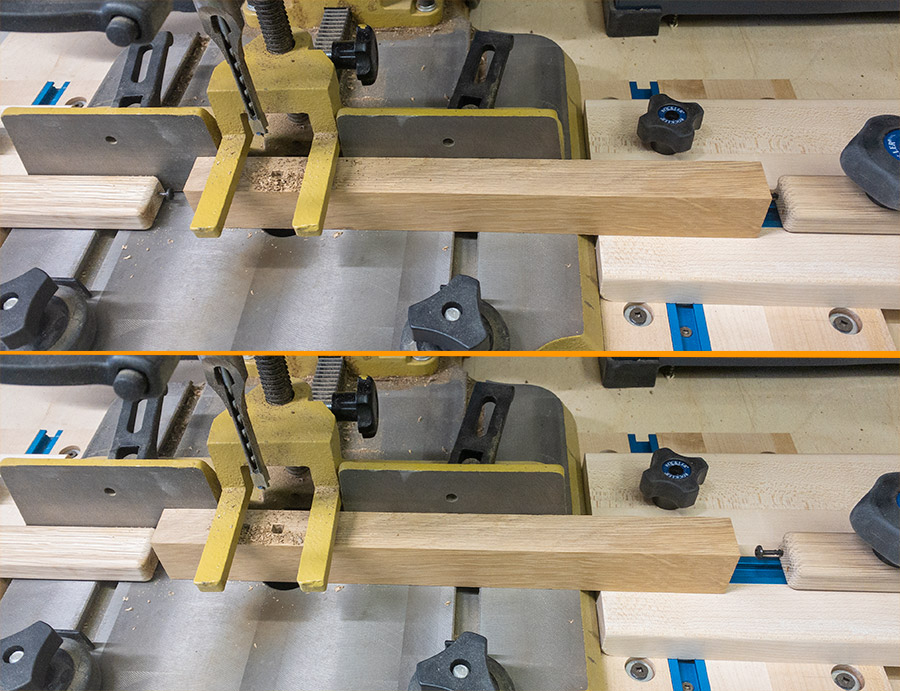
Alternatively, you can place the other stop at the end position and just slide your work back and forth. This only works if you used a stop when cutting all of the boards to the same length. Otherwise, using this approach will give you mortises of different sizes.
One other benefit of the Ultimate Mortise Stop System is that if you need to replace one of a set’s members, it’s very easy to insert the mortise bit into one of the previously made mortises, set the stop(s), then drill a new mortise in the new item.
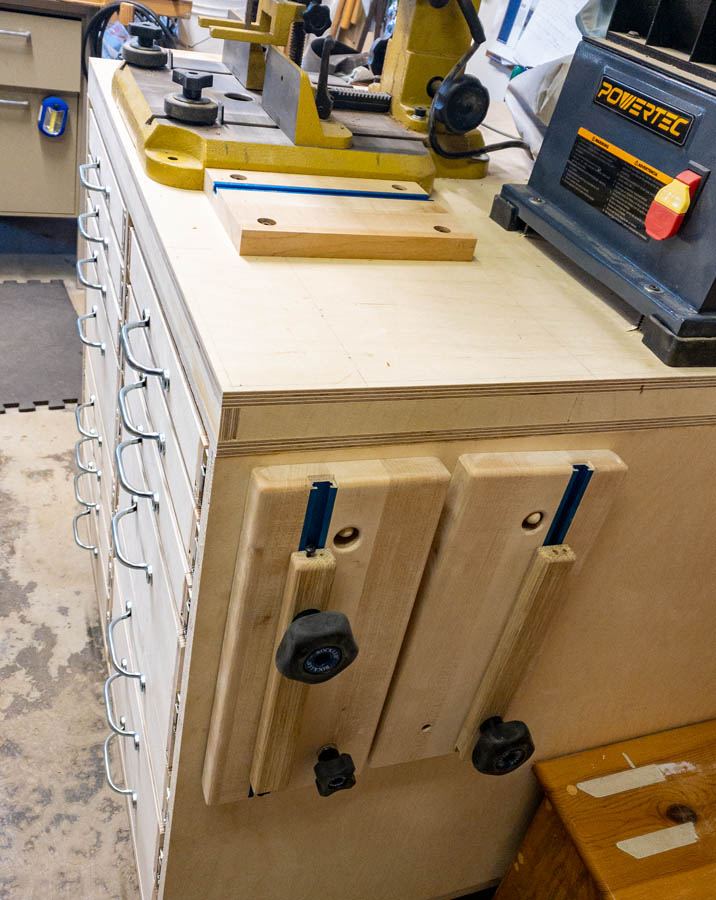
When you’re done for the day, the wings can be taken off and placed somewhere safe. If you’re like me and have a door next to your mortiser, you’ll want to remove the wings so you don’t smash your hip into the sharp corner. Speaking from experience, here.
How to Make the Ultimate Mortise Stop System
For both safety and consistency, you will need to bolt your mortiser down to your mortise table. However, before you bolt your mortiser down, be sure to double-check its placement and look for available room on both sides for the base. Make sure the wings have space to move and allow any wood to extend beyond the edges. Once you feel good about placements, go ahead and bolt the mortiser to your table.
The dimensions of my system are provided in the attached PDF just above the cut list located near the bottom of this article. Please note that all of the dimensions are relevant to my personal system and table. As such, all dimensions are provided as guides and suggestions. I recommend that you make this system for both sides of your mortiser, keep in mind that they should be mirror images of each other. The PDF provides both sides.
To make the pieces for your Ultimate Mortise Stop System, you should use a firm, strong wood like hard maple, oak, hickory, or other such wood.
The only dimension that’s critical is the combined thickness of the base and wing. These two parts stacked on top of each other must be the same height of your mortiser’s base. To start, you first need to prepare the thickness of the base and wings so that they are each half the thickness of your mortise’s base. I used my planer to sneak down to this thickness.
When cutting the grooves for the T-track, try to end up sinking the T-track just a tad (1/64” – 1/32”) below the wood surface to ensure that the track is below the wood surface. Check out this article for info on installing T-tracks in a drill press table. The same rules for installing a T-track in that construction apply here.
Tip: Assuming that your T-tracks are extruded aluminum (as most are), you should be able to cut them with a miter saw or table saw. With this method, I’ve been able to get much cleaner, nicer cuts than I ever could with a hacksaw.
T-tracks have a fastening hole about every four inches or so, and when you cut them into small pieces, the location of those may not be ideal. For things like this, I like holes every three inches, or within an inch of the end. When installing your T-tracks, you’ll probably need to drill an extra hole or two into the track itself that should also be countersunk. If your countersink can’t fit into the T-track, use the tip of a 1/4” drill, and be careful to not drill too deep. Tip: If your drill press has a stop on it, this makes it easier to countersink multiple holes.
To place the screws used to hold down the base, I used a Forstner bit to drill a wide hole to support the washers I had available and made it deep enough so that any screw head would not rise above the wood’s surface.
The length of the wings is up to you. The good thing about this modular system is that if you later realize that you need longer wings, you can make new ones that satisfy your needs. I used a router bit to create a roundover on the top three sides that weren’t adjacent to the mortiser.
You’ll also need to add a T-track that runs the length of the wing and a hole for the T-track bolt to go through. This must be in alignment with the T-track in the base. If you plan on hanging this, you’ll also need to add a ¾” hole.
Tip: You can use your roundover bit to remove the sharp edges of this hole.
The length of the stops can also be up to you, but the minimum length should be so that the end of the stop can touch the mortising bit. I also rounded over all sharp edges and placed a round-head screw on both ends to provide fast and easy micro-adjustments. These screws are offset to the left-side of each end so they can make contact with thinner pieces of wood.
Download The Ultimate Mortiser Stop System Plans

*These dimensions are from my stop system that fit my mortiser and my cabinet. You will likely need to adjust these measurements to your system.
Sources:
- T-track (about four feet total): https://www.rockler.com/universal-t-track-universal-t-track
- 2 x Knobs, Female Threading, 5/16” – 18 thread: https://www.rockler.com/rockler-easy-to-grip-4-star-knob-female-threading
- 2 x Knobs, Threaded Insert, 5/16” – 18 thread: https://www.rockler.com/rockler-easy-to-grip-5-star-knobs-threaded-insert
- 4 x 5/16” – 18 thread T-bolts: https://www.rockler.com/t-slot-bolts-5-16-18-thread-t-slot-bolts
(Note: For my system, the 1-1/2” bolts were just right. If your system has thicker or thinner components you may need longer or shorter bolts.)
I have that mortising machine and have used it many times. I draw on the wood exactly where I want the mortises. Then I lower the cutters until they touch the area. After that, I tighten up the clamps in front of and on top of the work piece. The work piece has nowhere to move. Then, I bore it out. When that is done, I loosen the clamps and move the work piece over into the next section. The mortise stop system described is totally unnecessary for the tasks using this mortising machine. But you are correct. 100% accuracy is impossible and rarely necessary unless you are building a racing engine.
Hey guys - First sentence: "The importance of stops on shop equipment cannot be understated." I think you mean "overstated". Stops offer "repeatability", not accuracy, and that was exactly your (very valid) point. I could not agree more. Or, I cannot say how little I disagree. Or, ...